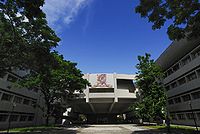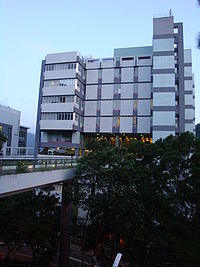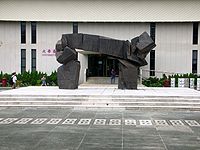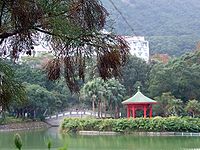Tradition and history
The university's founders hoped that it would become the bridge that connects China and the West, and to combine tradition with modernity.
The collegiate system
CUHK comprises four colleges: Chung Chi College, New Asia College, United College, and Shaw College. All undergraduates are affiliated to one of them. Currently, five new colleges are to be established in the near future; namely Morningside College , S. H. Ho College , C. W. Chu College, Wu Yee Sun College and Lee Woo Sing College.
Colleges are congenial communities with their own hostels, dining halls and other facilities. Students receive pastoral care and whole-person education, including formal and non-formal general education by means like interacting closely with teachers and peers. Colleges are active promoters of various extracurricular activities. They are also important platforms for discussions and friendships.

Science Center in the main campus

Hotel affiliated to the Hotel Management program

Ho Sin-Hang Building, home to the Faculty of Engineering
A brief history
- 1957, New Asia College, Chung Chi College, and United College established the Hong Kong Chinese Higher Education Association, same year, the colleges received government funding and academic status.
- 1959, New Asia College, Chung Chi College, and United College became government funded institutions of higher education.
- 1963, New Asia College, Chung Chi College, and United College combined to become The Chinese University of Hong Kong.
- 1965, School of Education established.
- 1976, The Chinese University of Hong Kong Ordinance enacted, CUHK was established as a collegiate university.
- 1977, School of Medicine established.
- 1986, Shaw College established.
- 1991, School of Engineering established.
- 2005, School of Law established.
- 2006, the establishment of two new colleges, Morningside College and S. H. Ho College, was announced.
- 2007, the establishment of another three colleges, C. W. Chu College, Wu Yee Sun College and Lee Woo Sing College, was announced.
Funding
In 2005, The Chinese University of Hong Kong's budget was HK$4,558 million, with government subventions of about HK$2,830 million.
The University's School of Continuing and Professional Studies (SCS) was established in 1965 under the name of the Department of Extramural Studies. In January 2006, the School was renamed the School of Continuing and Professional Studies. Bearing the mission of providing quality continuing professional education programmes and services to meet the changing needs of society, the School offers a diverse range of courses and programs at different levels.
Libraries and Museum

Artwork outside of the University Library
Main article: Art Museum of the Chinese University of Hong Kong
The university library system houses the Hong Kong Studies Archive, Hong Kong Literature Collection, Chinese Overseas Collection, Nobel Laureate GAO, Xingjian Collection, Nobel Laureate CY Yang Archive, American Studies Resource Collection and Modern Chinese Drama Collection, which highlight the distinctive CUHK stock of literature in Hong Kong.
CUHK also houses The Chinese University of Hong Kong Art Museum, which houses "a wide range of artifacts illuminating the rich arts, humanities and cultural heritage of ancient and pre-modern China."
Faculties
There are nine main faculties at CUHK:
- Faculty of Arts
- Faculty of Business Administration
- Faculty of Education
- Faculty of Engineering
|
- Faculty of Medicine/CUHK Medical School
- Faculty of Social Science
- Faculty of Science
- Faculty of Law
- The Graduate School.
|
Each faculty regulates different undergraduate degrees accordingly.
Chinese Language Center
Main article: New Asia--Yale-in-China Chinese Language Center
New Asia—Yale-in-China Chinese Language Center (CLC) was founded in 1963 under the joint auspices of New Asia College and the Yale-China Association, the Center became part of The Chinese University in 1974 and has been responsible for the teaching of one language education (Putonghua and Cantonese) of University students as well as other Putonghua and Cantonese learners. Courses are offered in two different series namely (i) for non-native speakers and (ii) for native speakers of Chinese. All the series have different levels to meet the needs and aptitude of students.
University Programs are divided into (a) Putonghua Courses for Local Students (b) Cantonese Courses for Mainland Chinese Students and (c) Putonghua and Cantonese Courses for International Exchange Students
Programs are provided to public as well in 2 difference streams namely (a) Putonghua/ Cantonese courses for non-native speakers (Chinese as a foreign language/second language, CFL), and (b) Putonghua/ Cantonese courses for native Chinese speakers.
Campus culture

The "Lion Pavilion" near Chung Chi College
There are many artworks on the campus; mostly representing Chinese culture, such as the Statue of Confucius within the New Asia College campus, the Lion Pavilion in the Chung Chi College, and the Ming De Mural in the United College.
Transportation
Although the campus is located away from the busier districts in Hong Kong, access to campus is relatively quick and easy. The university connects itself with the other districts of the city via the Mass Transit Railway and the Hong Kong bus system. Buses and trains stop by Chung Chi College.
See Maps of the Shatin main campus: Campus Maps
Hostels and dorms
Due to high demand, only about half of CU students are offered a dormitory room. There are a total of 23 dormitory halls, each of which belongs to one of the four colleges. There are also six additional halls for graduate students.
Presidents
- (1963-1978)Professor Choh-Ming Li (李卓敏教授)
- (1978-1987)Professor Ma Lin (馬臨教授)
- (1987-1996)Professor Charles K. Kao (高錕教授), Laureate of the Nobel Prize in Physics 2009
- (1996-2002)Professor Arthur Li (李國章教授)
- (2002-2004)Professor Ambrose King (金耀基教授)
- (2004-2010)Professor Lawrence J. Lau (劉遵義教授)
- (2010-) Professor Joseph Jao-yiu Sung (沈祖堯教授)
CUHK people
Main article: List of Chinese University of Hong Kong people
Focused Areas of Research
To maximize impact and benefit to society, CUHK has adopted in its Strategic Plan 2006 the strategy of focusing its research investments in five already distinguished fields of academic enquiry within the University
- Chinese Studies
- Biomedical Sciences
- Information Sciences
- Economics and Finance
- Geoinformation and Earth Sciences
更多
- Education in Hong Kong
- List of universities in Hong Kong
- List of buildings and structures in Hong Kong
参考文献
- ^ http://www.econ.cuhk.edu.hk/dept/staffPersonal.php?st_id=mundell&title=PROD&isHead=N
- ^ Distinguished Faculty Members
- ^ CU introduction
- ^ CUHK College system
- ^ Morningside
- ^ S.H. Ho College
- ^ CUHK Income and Expenditure 2004-2005
- ^ http://nobelprize.org/nobel_prizes/physics/laureates/2009/
- ^ http://www.cuhk.edu.hk/english/research/research-study.html
External links
 |
Wikimedia Commons has media related to: Chinese University of Hong Kong |
- The Chinese University of Hong Kong - Official website
- Chung Chi College
- New Asia College
- United College
- Shaw College
- New Colleges
- 40 years of CUHK
- Centre for Innovation and Technology (CINTEC)



